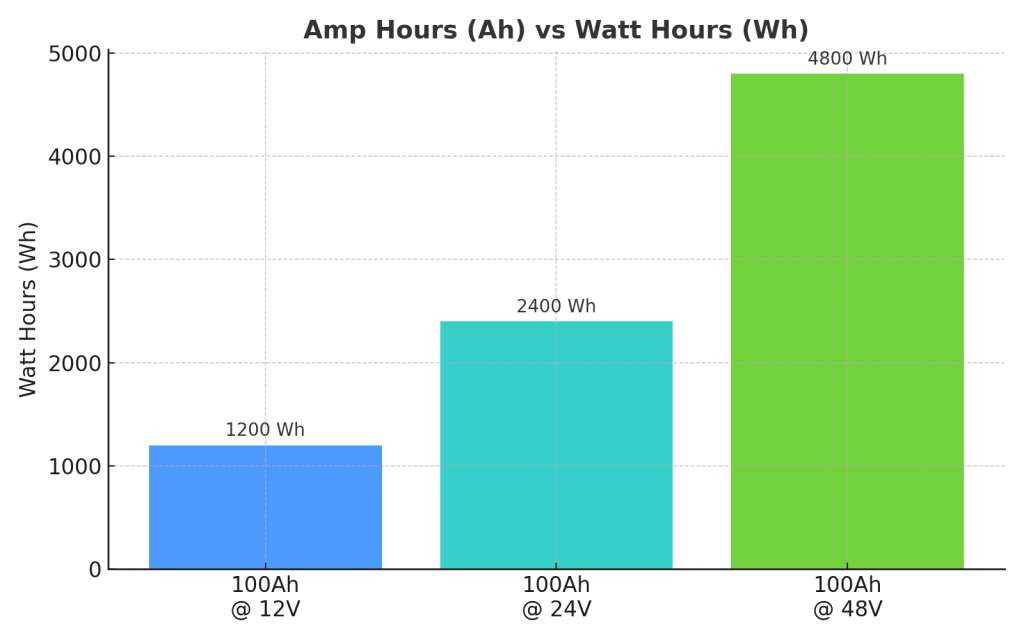When it comes to solar energy and battery storage, two terms often create confusion: Amp Hours (Ah) and Watt Hours (Wh). Both are related to battery capacity, but they measure different things. Understanding the difference between them is essential for anyone working with solar power systems, inverters, or energy storage solutions.
In this article, we will break down what Amp Hours and Watt Hours really mean, how to calculate them, and why both are important for choosing the right battery setup.
What Are Amp Hours (Ah)?
Amp Hours (Ah) represent the total amount of current a battery can deliver over a period of time. It’s a measure of the battery’s capacity.
👉 For example, a 100Ah battery can theoretically provide 100 amps for one hour, or 10 amps for 10 hours.
Key Example:
-
A 100Ah battery at 12 volts
-
A 100Ah battery at 24 volts
-
A 100Ah battery at 48 volts

Even though each battery has the same “100Ah” label, the actual energy stored in each is different because of the voltage.
What Are Watt Hours (Wh)?
Watt Hours (Wh) measure the total amount of energy stored in a battery. It’s calculated using a simple formula:
Watt Hours (Wh) = Amp Hours (Ah) × Voltage (V)
Example Calculation:
-
100Ah × 12V = 1200Wh
-
100Ah × 24V = 2400Wh
-
100Ah × 48V = 4800Wh
This makes watt-hours the most accurate way to compare different batteries, because it shows the real amount of energy available.
Amp Hours vs Watt Hours: The Practical Difference
-
Amp Hours (Ah): Tells you the storage capacity of a battery in terms of current.
-
Watt Hours (Wh): Tells you the actual amount of energy available for your devices.
If a fan requires 100 watts to run:
-
A 1200Wh battery could run it for about 12 hours (1200 ÷ 100 = 12).
But keep in mind — batteries should never be fully discharged.
-
For lead acid batteries, use only about 50% of the capacity.
-
For lithium iron phosphate batteries, you can safely use about 80%.
Why Do We Still Use Amp Hours?
If watt-hours give a clearer energy picture, why do manufacturers still use amp-hours?
The answer lies in C-rate.
What Is C-Rate?
C-rate indicates how fast a battery can be charged or discharged safely.
-
Lithium batteries typically have a C-rate of 1C.
-
Lead-acid batteries often have a C-rate of 0.2C (or 2C in some ratings).
Example:
-
A 100Ah lithium battery can provide 100 amps safely.
-
A 100Ah lead-acid battery might only safely deliver 20 amps.
Drawing more current than recommended reduces the battery’s lifespan and efficiency.
Choosing the Right Battery for Solar Power Systems
When designing or upgrading a solar battery bank, always:
-
Look at watt-hours (Wh) to compare actual energy capacity.
-
Consider the depth of discharge (DoD) to avoid damaging the battery.
-
Factor in the C-rate to make sure your load can be supported.
By using both amp-hours and watt-hours, you’ll get a complete picture of your battery’s performance.
Conclusion
In simple terms:
-
Amp Hours (Ah) = Storage capacity (like the size of a fuel tank).
-
Watt Hours (Wh) = Usable energy (like the actual fuel inside).
Understanding the difference between Ah and Wh is key for solar power system design, inverter sizing, and battery storage planning. Whether you’re using lead-acid or lithium batteries, always calculate both values to ensure your system performs efficiently.
Frequently Asked Questions (FAQ)
1. What is the difference between Amp Hours (Ah) and Watt Hours (Wh)?
Amp Hours (Ah) show the capacity of a battery in terms of current flow over time, while Watt Hours (Wh) measure the actual energy stored by multiplying volts × amp-hours.
2. Why are Watt Hours more accurate than Amp Hours?
Watt Hours take into account both the capacity (Ah) and the voltage (V), giving a complete picture of how much usable energy a battery can provide.
3. How do I calculate Watt Hours from Amp Hours?
Use this formula: Wh = Ah × V.
For example, a 100Ah battery at 12V = 1200Wh.
4. Can I fully discharge my battery to 0%?
No. Discharging completely shortens battery life.
-
Use only about 50% for lead-acid batteries.
-
Use about 80% for lithium iron phosphate batteries.
5. What is the C-rate of a battery?
C-rate measures how fast a battery can be charged or discharged safely. For example:
-
A 100Ah lithium battery at 1C can safely deliver 100A.
-
A 100Ah lead-acid battery at 0.2C may only safely provide 20A.
6. How do I know which battery is best for solar power?
Choose based on:
-
Watt Hours (for total energy storage)
-
Depth of Discharge (DoD)
-
C-rate (safe charging/discharging)
-
Your system’s voltage and power requirements
7. Which is better for solar systems: Lead Acid or Lithium?
-
Lead Acid: Cheaper, but heavier, less efficient, and limited to ~50% usable capacity.
-
Lithium (LiFePO4): More expensive upfront, but lighter, lasts longer, supports deeper discharge, and is more efficient for solar setups.
Leave a Reply